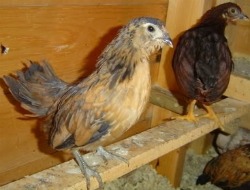Bearded D'Anvers Bantam: The True Bantam
The Bearded D'Anvers Bantam chicken breed is only available as a bantam with no standard sized counterpart. They are a good layer of small white eggs.
Bearded D'Anvers Bantam Facts:
Class: Rose Comb, Clean Legged
Size: Male: 26 oz. Female: 22 oz.
Comb, Wattles & Earlobes: The rose comb is small and covered with rounded points. Breeders prefer birds with small or absent wattles. The earlobes are flat and almond shaped but generally hidden by the muffs. All of these are bright red.
Color: The beak is various shades of horn and the eyes are reddish bay, unless otherwise noted. The beards and muffs are the same color as the plumage, unless otherwise noted.
Black: The eyes are black and the shanks and toes are bluish black to slate. They have standard black plumage.
Black-Breasted Red: The beards and muffs are black and the shanks and toes light slaty blue. They have standard black-breasted red plumage.
Blue: The eyes are dark brown and the shanks and toes are bluish to black slate. They have standard blue plumage.
Blue Quail: The eyes are dark brown and the beard and muffs are brownish yellow. The shanks and toes are slaty blue. Male: The head, hackle, back, and saddle are brilliant bluish black laced with golden bay. The breast, body, and leg feathers are brownish yellow laced with a more intense shade of brownish yellow and straw shaft. The tail and wings are blue to black with some lacing. Female: The head is bluish black tinged with yellow. The hackle and back are blue to bluish black laced with golden bay. The breast, body, and leg feathers are brownish yellow laced with a lighter shade of brownish yellow and straw shaft. The tail and wings are blue to black with some lacing.

Buff: The shanks and toes are slaty white. They have standard buff plumage.
Buff Columbian: The shanks and toes are slaty blue and they have standard buff Columbian plumage.
Columbian: The beard and muffs are buff and the shanks and toes are slaty blue. They have standard Columbian plumage.
Cuckoo: They have bright red eyes and bluish white shanks and toes. They have standard cuckoo plumage.
Mille Fleur: The shanks and toes are slaty blue and they have standard mille fleur plumage.
Mottled: The shanks and toes are slate and they have standard mottled plumage.
Porcelain: The shanks and toes are light slaty blue and they have standard porcelain plumage.
Quail: They have dark brown eyes and slate blue shanks and toes. The beard and muffs are brownish yellow. Male: The head, hackle, back, saddle, and wings are brilliant black laced with golden bay. The front of the neck, breast, body, and legs are brownish yellow. The tail is black. Female: The head is chocolaty black tinged with yellow. The neck is lustrous chocolaty black laced with golden bay. The front of the neck, breast, and body are brownish yellow laced with a lighter shade of the same color. The tail and wings are chocolaty black laced with light brownish yellow.
Self Blue: The eyes are brown and the shanks and toes are slate. They have standard self blue plumage.
White: The shanks and toes are slaty blue to pinkish gray. They have standard white plumage.
Place of Origin: Belgium
Conservation Status: N/A
Special Qualities: They are only available as a bantam.
The Bearded D'Anvers Bantam are a true bantam that were once known as the Begium Antwerp. They are an old breed. Their ancestry is unclear, but evidence does indicate that their ancestors were present in the Netherlands and Belgium since the middle of the 1600's.
By the mid-1800's, the selection was well underway for several of the varieties that are present today. Their popularity continued to increase through the first half of the twentieth century as many fanciers took to the breed.
As the name implies, the Bearded D'Anvers Bantam is bearded with thick muffs that cover the earlobes. It is an active breed, but can do alright in small areas and does tame down rather easily. The hens lay small white eggs and will go broody. The beard is unique in its asymmetric body. It stands tall and carries it's weight forward.
The Bearded D'Anvers Bantam was first admitted to the APA in 1949.

Custom Search



New! Comments
Have your say about what you just read! Leave me a comment in the box below.